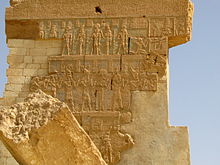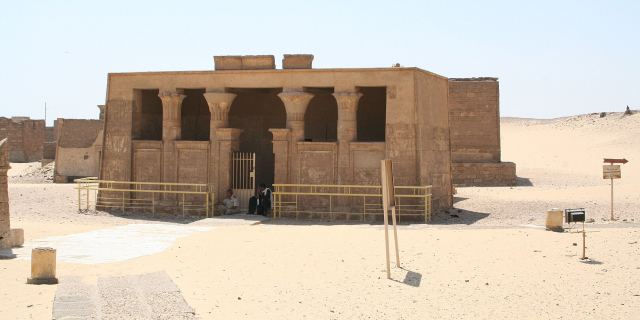سيوة
( Siwa Oasis )
The Siwa Oasis (Arabic: واحة سيوة Wāḥat Sīwah [ˈwæːħet ˈsiːwæ]) is an urban oasis in Egypt. It is situated between the Qattara Depression and the Great Sand Sea in the Western Desert, 50 kilometres (31 mi) east of the Egypt–Libya border and 560 kilometres (350 mi) from the Egyptian capital city of Cairo. It is famed from its role in ancient Egypt as the home to an oracle of Amun, the ruins of which are a popular tourist attraction, giving it the ancient name Oasis of Amun-Ra, after the major Egyptian deity.
 The Siwa Oasis is vast, extending beyond the horizon
The Siwa Oasis is vast, extending beyond the horizon Site of the Siwa Oasis in Egypt (top left)
Site of the Siwa Oasis in Egypt (top left) Last standing wall at the Temple of Amun at Umm 'Ubeida
Last standing wall at the Temple of Amun at Umm 'Ubeida Siwa Oasis from space. January 23, 2023
Siwa Oasis from space. January 23, 2023Although the oasis is known to have been settled since at least the 10th millennium BC, the earliest evidence of any connection with Ancient Egypt is the 26th Dynasty, when a necropolis was established. Ancient Greek settlers at Cyrene made contact with the oasis around the same time (7th century BC), and the oracle temple of Amun (Greek: Zeus Ammon), who, Herodotus was told, took the image here of a ram. Herodotus knew of a "fountain of the Sun" that ran coldest in the noontime heat.[1] During his campaign to conquer the Persian Empire, Alexander the Great reached the oasis, supposedly by following birds across the desert. The oracle, Alexander's court historians alleged, confirmed him as both a divine personage and the legitimate Pharaoh of Egypt, though Alexander's motives in making the excursion, following his founding of Alexandria, remain to some extent inscrutable and contested.[2] During the Ptolemaic Kingdom, its Ancient Egyptian name was sḫ.t-ỉm3w, meaning "Field of Trees".[3]
In the 12th century, Al-Idrisi mentions it as being inhabited mainly by Berbers, with an Arab minority; a century before Al-Bakri stated that only Berbers lived there. The Egyptian historian Al-Maqrizi traveled to Siwa in the 15th century and described how the language spoken there 'is similar to the language of the Zenata'.[4]
The first European to visit since Roman times was the English traveler William George Browne, who came in 1792 to see the ancient temple of the Oracle of Amun.[5] Bompiani, in her description of the 19th-century explorer Luigi Robecchi Bricchetti, called this site the Oasis of Jupiter Ammon.[6]
Siwa was annexed by Muhammad Ali of Egypt in 1820, but the Egyptian representative in Siwa was assassinated in 1838.[7] At some point, Muhammad al-Sanusi stayed at Siwa for a few months and gathered some followers there.[7] Later, Siwa was a base of the Sanusiyya in their fight against the British from 1915 to 1917.[7] Meanwhile, in the spring of 1893, German explorer and photographer Hermann Burchardt took photographs of the architecture of the town of Siwa, now stored at the Ethnological Museum of Berlin.[8]
Egyptian rule from distant Cairo was at first tenuous and marked by several revolts. Egypt began to assert firmer control after a 1928 visit to the Oasis by King Fuad I, who berated the locals for homosexual practices and specified punishments to bring Siwan behaviour in line with Egyptian morals.
Siwa was also the site of some fighting during World War I and World War II. The British Army's Long Range Desert Group (LRDG) was based here, but Rommel's Afrika Korps also took possession three times. German soldiers went skinny dipping in the lake of the oracle, contrary to local customs which prohibit public nudity.[9] In 1942 while the Italian 136th Infantry Division Giovani Fascisti occupied the oasis, a tiny Egyptian puppet government-in-exile was set up at Siwa. The oasis makes a brief appearance as a base of the LRDG in the 1958 war film Ice Cold in Alex.
The ancient fortress of Siwa, known as the Shali Ghadi (Shali being the name of the town, and Ghadi meaning "remote"), was built on natural rock (an inselberg) and made of kershif (salt and mud-brick)[5] and palm logs. After it was damaged by three days of heavy rains in 1926[10] it was abandoned for similar unreinforced construction housing on the plain surrounding it, and in some cases those, in turn, have been replaced by more modern cinder block and sheet metal roof buildings. Only one building in the Shali complex has been repaired and is in use, a mosque. Gradually eroded by infrequent rains and slowly collapsing, the Shali remains a prominent feature, towering five stories above the modern town and lit at night by floodlights. It is most easily approached from its southwest side, south of the end of the paved road which curves around from the north side of the Shali. Several uneven pedestrian streets lead from the southwest end of the Shali into it, and the ground is rent in places by deep cracks. Many of the unreinforced kershif buildings bordering the streets of the Shali are also split by large cracks, or they are partially collapsed.
Other local historic sites of interest include the remains of the oracle temple; the Gebel al Mawta (the Mountain of the Dead), a Roman-era necropolis featuring dozens of rock-cut tombs;[5] and "Cleopatra's Bath", an antique natural spring. The fragmentary remains of the oracle temple, with some inscriptions dating from the 4th century BC, lie within the ruins of Aghurmi. The revelations of the oracle fell into disrepute under the Roman occupation of Egypt.[5]





























Add new comment